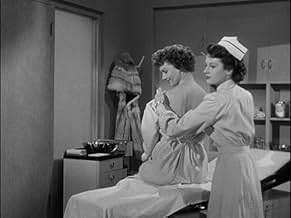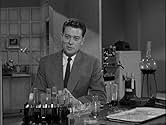IMDb रेटिंग
5.8/10
1.1 हज़ार
आपकी रेटिंग
अपनी भाषा में प्लॉट जोड़ेंA doctor returning from the Korean War to his hometown in Pennsylvania must choose what next to do with his life.A doctor returning from the Korean War to his hometown in Pennsylvania must choose what next to do with his life.A doctor returning from the Korean War to his hometown in Pennsylvania must choose what next to do with his life.
Philip Ahlm
- Minor Role
- (बिना क्रेडिट के)
Elsie Baker
- Mrs. Olzoneski
- (बिना क्रेडिट के)
Mary Benoit
- Party Guest
- (बिना क्रेडिट के)
फ़ीचर्ड समीक्षाएं
Bad for Each Other (1953)
Charlton Heston gets a bad rap sometimes--maybe that's what you expect after "Planet of the Apes"--but here he is the charming, confident, larger than life young man that made him famous. Yes, it's a B-movie, but it's a very strong performance for Heston and he is surrounded by a cast that is decent (Lizabeth Scott not at her best, which is saying a lot) to terrific (Ray Collins as the big business power guy he plays so well). The "business" at the center is a coal mine in a small Pennsylvania town, and Heston plays a doctor, Tom Owen, getting out of the military in a pseudo-noir kind of echo. Owen's dilemma is a worldly one--whether to doctor rich old women with frivolous pains or to work for the miners in their lower class afflictions.
And it is Lizabeth Scott, a pampered (and unabashedly pampered) rich girl who snags our hero, and so against his initial instinct Heston goes the rich and lazy way. But of course the coal mining town is all around him, and reminders pop up now and then. It's a great problem for a movie, and it's worked out with fairly predictable logic, so there is nothing to really fault here. Except that very predictability. Even Scott is a bit bland, not really getting to run her coolness to true ice. Some of the side characters are well developed, surprisingly (a "good" doctor untainted by money and an old woman who is wiser than she lets on at first), and director Irving Rapper (who should have been a music star in the 1990s with a name like that) makes it pop pretty well.
The less than sterling reputation of this movie is unwarranted, but it may be a result of higher expectations than this kind of movie deserves. Yes, the plot is boilerplate stuff, but so are half the movie plots out there. And Heston is sort of terrific. Yes, he plays a type, and he doesn't give the angst some other actor might, but I don't think the character, Dr. Owen, was an angst-y kind of guy. The way he wrestles with things is believable.
The cinematography by Franz Planer is better than I'd expected (the name didn't ring a bell) and there are small sterling moments, the camera moving around a group of people at a table, or across a wrought iron screen as the two leads start to hit it off. Nice stuff. The title is wrong, by the way--it's only Scott's character who is bad for the doctor, not the other way around. She's not about to be affected by anyone, especially a handsome young ex-GI who is such easy prey.
Charlton Heston gets a bad rap sometimes--maybe that's what you expect after "Planet of the Apes"--but here he is the charming, confident, larger than life young man that made him famous. Yes, it's a B-movie, but it's a very strong performance for Heston and he is surrounded by a cast that is decent (Lizabeth Scott not at her best, which is saying a lot) to terrific (Ray Collins as the big business power guy he plays so well). The "business" at the center is a coal mine in a small Pennsylvania town, and Heston plays a doctor, Tom Owen, getting out of the military in a pseudo-noir kind of echo. Owen's dilemma is a worldly one--whether to doctor rich old women with frivolous pains or to work for the miners in their lower class afflictions.
And it is Lizabeth Scott, a pampered (and unabashedly pampered) rich girl who snags our hero, and so against his initial instinct Heston goes the rich and lazy way. But of course the coal mining town is all around him, and reminders pop up now and then. It's a great problem for a movie, and it's worked out with fairly predictable logic, so there is nothing to really fault here. Except that very predictability. Even Scott is a bit bland, not really getting to run her coolness to true ice. Some of the side characters are well developed, surprisingly (a "good" doctor untainted by money and an old woman who is wiser than she lets on at first), and director Irving Rapper (who should have been a music star in the 1990s with a name like that) makes it pop pretty well.
The less than sterling reputation of this movie is unwarranted, but it may be a result of higher expectations than this kind of movie deserves. Yes, the plot is boilerplate stuff, but so are half the movie plots out there. And Heston is sort of terrific. Yes, he plays a type, and he doesn't give the angst some other actor might, but I don't think the character, Dr. Owen, was an angst-y kind of guy. The way he wrestles with things is believable.
The cinematography by Franz Planer is better than I'd expected (the name didn't ring a bell) and there are small sterling moments, the camera moving around a group of people at a table, or across a wrought iron screen as the two leads start to hit it off. Nice stuff. The title is wrong, by the way--it's only Scott's character who is bad for the doctor, not the other way around. She's not about to be affected by anyone, especially a handsome young ex-GI who is such easy prey.
Maybe if John Garfield had been cast instead of Charlton Heston (who looks and moves like Frankinstein's monster here); and if the producers (writers? director?) had not backed away from the mine safety, health, and company criminal negligence theme that packs a punch in the first ten minutes of the movie.
(1953) Bad For Each Other
DRAMA
Co-written and directed by Irving Rapper that opens with a colonel, Thomas Owen (Charlton Heston) or Tom for short coming back to a mining town, Coalville and finds out his brother had long been past, that he may not be on the up and up as told by mother, Mrs. Mary Owen (Mildred Dunnock). So he then goes and visits the owner of the coal mine, Dan Reasonover (Ray Collins) and finds out that he stole and owed money to the coal mining comp as well as the owner Reasonover. During this, Dan Reasonover's daughter, Helen Curtis then becomes infatuated by him and tries to convince him to become a doctor for the upper class as a profession and drop from being one for the army. He does, and at the same time falls for Helen and let's her to drop what he wanted to do to become an associate for Dr. Homer Gleeson (Lester Matthews). And while he is in love with Helen, both Tom's own mother as well as Helen's dad disapproves of the match once he proposes to her.
The dilemma unfolds when Tom decides to break ethic rules by letting his boss Dr. Homer Gleeson to take full credit for a surgery he had done, forcing the nurse he had recently hired and respects to move to quit working for him and work for a much smaller clinic for the workers of Coalville.
It is kind of odd, this movie was selected to be shown on TCM Eddie Muller's Noir Alley when the overall experience is more drama than noir. And upon listening to Eddie Muller both from the introduction and afterward, I do not recall, why he thought this was film noir as their was no murder involve at all, but just some dilemmas.
Co-written and directed by Irving Rapper that opens with a colonel, Thomas Owen (Charlton Heston) or Tom for short coming back to a mining town, Coalville and finds out his brother had long been past, that he may not be on the up and up as told by mother, Mrs. Mary Owen (Mildred Dunnock). So he then goes and visits the owner of the coal mine, Dan Reasonover (Ray Collins) and finds out that he stole and owed money to the coal mining comp as well as the owner Reasonover. During this, Dan Reasonover's daughter, Helen Curtis then becomes infatuated by him and tries to convince him to become a doctor for the upper class as a profession and drop from being one for the army. He does, and at the same time falls for Helen and let's her to drop what he wanted to do to become an associate for Dr. Homer Gleeson (Lester Matthews). And while he is in love with Helen, both Tom's own mother as well as Helen's dad disapproves of the match once he proposes to her.
The dilemma unfolds when Tom decides to break ethic rules by letting his boss Dr. Homer Gleeson to take full credit for a surgery he had done, forcing the nurse he had recently hired and respects to move to quit working for him and work for a much smaller clinic for the workers of Coalville.
It is kind of odd, this movie was selected to be shown on TCM Eddie Muller's Noir Alley when the overall experience is more drama than noir. And upon listening to Eddie Muller both from the introduction and afterward, I do not recall, why he thought this was film noir as their was no murder involve at all, but just some dilemmas.
A freshly discharged army doctor passes up practice in blue-collar hometown for big- paying practice among a city elite that includes a cool blonde dilettante.
I got this epic as part of a package claiming to be all noir. The only thing noir in this movie are the several night time shots— otherwise, no crime, no hand of fate, and no moody atmosphere. Only blonde seductress Helen (Scott) instead, and she's hardly the standard spider woman. Actually, the movie's more b&w soap opera than anything else.
That's not to say there're no redeeming features. I guess I wasn't aware of what a racket doctoring among the wealthy can be. The movie shows what a cushy pandering job it can be, treating headaches with high-priced medicines and smarmy words. And coming from a muckraker like novelist McCoy, e.g. They Shoot Horses Don't They (1969), I take it as factually based.
And surprise, surprise, to me, at least—actor Heston is quite animated as the sell-out doctor. I guess this was before he stiffened into a big-screen movie god, but whatever, he's quite persuasive in the role. Still, I thought the script made the doc's transition from honorable soldier to money-grubbing pill pusher much too easy, more like a movie device than a character change. Nonetheless, get a load of the coal mine scenes, quite realistic and well done.
But, bottom line, the story follows a familiar pattern with no surprises, suggesting a production serving mainly as a vehicle for Columbia's newest hunk.
I got this epic as part of a package claiming to be all noir. The only thing noir in this movie are the several night time shots— otherwise, no crime, no hand of fate, and no moody atmosphere. Only blonde seductress Helen (Scott) instead, and she's hardly the standard spider woman. Actually, the movie's more b&w soap opera than anything else.
That's not to say there're no redeeming features. I guess I wasn't aware of what a racket doctoring among the wealthy can be. The movie shows what a cushy pandering job it can be, treating headaches with high-priced medicines and smarmy words. And coming from a muckraker like novelist McCoy, e.g. They Shoot Horses Don't They (1969), I take it as factually based.
And surprise, surprise, to me, at least—actor Heston is quite animated as the sell-out doctor. I guess this was before he stiffened into a big-screen movie god, but whatever, he's quite persuasive in the role. Still, I thought the script made the doc's transition from honorable soldier to money-grubbing pill pusher much too easy, more like a movie device than a character change. Nonetheless, get a load of the coal mine scenes, quite realistic and well done.
But, bottom line, the story follows a familiar pattern with no surprises, suggesting a production serving mainly as a vehicle for Columbia's newest hunk.
Charlton Heston and Lizabeth Scott are "Bad for Each Other" in this predictable 1953 film, also starring Mildred Dunnock, Arthur Franz, Marjorie Rambeau, and Dianne Foster.
Heston plays a doctor who returns from the service to the coal town where he grew up. After meeting the wealthy, twice-married, shallow Scott, he decides not to stay in the service and becomes a society doctor, in it for the money. The nurse he hires to work for him (Foster) thinks he's better than that.
The role played by Arthur Franz, that of a young doctor who admires him and doesn't mind going into the trenches, is essentially Heston's conscience.
I found this film pretty bland, but the big problem for me was that the main character as portrayed by Heston was just not likable. He wasn't likable before he took up with Scott nor was he likable throughout the film. Some of this was in the script, but some of it was in his line readings. He had fat attitude every time he opened his mouth. Frankly I didn't care what he did.
Lizabeth Scott was best earlier in her career, in her noir days, where her great voice, sexy blond looks, and ambiguous performances fit very well. Her character in this also was annoying. Now, she's not supposed to be likable, but we should have been able to see why Heston liked her. She seemed awfully pushy for his character to have put up with her.
Heston was tall, handsome, with a great voice and a dominating presence. This film was unfortunately directed in a somewhat old-fashioned manner so as to seem melodramatic and over the top. When someone with that strong a screen persona is directed that way, his performance becomes too actor-y.
Nothing special.
Heston plays a doctor who returns from the service to the coal town where he grew up. After meeting the wealthy, twice-married, shallow Scott, he decides not to stay in the service and becomes a society doctor, in it for the money. The nurse he hires to work for him (Foster) thinks he's better than that.
The role played by Arthur Franz, that of a young doctor who admires him and doesn't mind going into the trenches, is essentially Heston's conscience.
I found this film pretty bland, but the big problem for me was that the main character as portrayed by Heston was just not likable. He wasn't likable before he took up with Scott nor was he likable throughout the film. Some of this was in the script, but some of it was in his line readings. He had fat attitude every time he opened his mouth. Frankly I didn't care what he did.
Lizabeth Scott was best earlier in her career, in her noir days, where her great voice, sexy blond looks, and ambiguous performances fit very well. Her character in this also was annoying. Now, she's not supposed to be likable, but we should have been able to see why Heston liked her. She seemed awfully pushy for his character to have put up with her.
Heston was tall, handsome, with a great voice and a dominating presence. This film was unfortunately directed in a somewhat old-fashioned manner so as to seem melodramatic and over the top. When someone with that strong a screen persona is directed that way, his performance becomes too actor-y.
Nothing special.
क्या आपको पता है
- ट्रिवियाAccording to December 1950 articles in The Hollywood Reporter and the Los Angeles Times, producer Hal B. Wallis purchased the rights to the novel before it was published for $100,000 ($1.3M in 2024). Wallis intended the leads to be Burt Lancaster and Patricia Neal and that the project was to be filmed at Paramount. It never got off the ground, and Wallis ended up selling the rights to Columbia in early 1953.
- गूफ़The beginning scenes of movie show coal mine operations in Coalville, PA. The railroad caboose was from ATSF (Atchison, Topeka, and Santa Fe). That railroad never had operations in Pennsylvania.
- भाव
Dr. Tom Owen: [on the phone with his wife] Oh, I'm interviewing nurses, of course... Don't be silly, darling - of course she'll be fat and ugly. I do insist on good legs, though.
टॉप पसंद
रेटिंग देने के लिए साइन-इन करें और वैयक्तिकृत सुझावों के लिए वॉचलिस्ट करें
- How long is Bad for Each Other?Alexa द्वारा संचालित
विवरण
- चलने की अवधि1 घंटा 23 मिनट
- रंग
इस पेज में योगदान दें
किसी बदलाव का सुझाव दें या अनुपलब्ध कॉन्टेंट जोड़ें




































